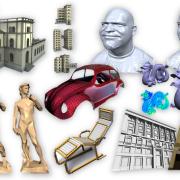We propose new methods to allow efficient and interactive procedural generation of building interiors. The goal will be to use procedural modeling, graph theory and optimization methods for the automated design of highly detailed, furnished rooms.
Our techniques will greatly extend the range of high-quality indoor environments that can be efficiently created by individual users. This will be achieved by (1) a high level of abstraction by description of object classes, (2) the automated creation of designs, and (3) the reusability and variability of created designs.
Target applications include indoor architecture design, everyday furniture planning, real estates marketing, digital content creation for games and movies, facility management, historical and archaeological visualizations and many more.
For automated model creation, we will improve the concept of shape grammars. A data-driven design approach will transform semantic description of interior designs to geometric models. It will select and combine grammar rules from a special evolving repository and use the resulting procedures for creation of a large variety of original models. User interaction will be minimized by utilization of abstract descriptions, however direct geometry editing will be still possible.
Our approach will also allow efficient editing of existing designs with automatic preservation of semantic and geometric plausibility. As interiors are often created in many iterations, the costs of refinement steps and error corrections will be strongly reduced.
Current procedural techniques for interiors are focused on very specific, partial problems. Our results will become a part of a unified content production pipeline for creation of multi-scale urban environments from the city level all the way to furnished interiors of single houses. The research will be divided into three main computer graphics basic research problems:
1. Floor planning divides a floor into rooms. Semantics and architectural knowledge determine their connections, sizes and shapes. Our contribution will be a graph-based layout algorithm for arbitrarily shaped rooms with a guarantee of no empty spaces and a minimum of parameters.
2. Furniture placement arranges furniture items inside of a room. Mutual relations, functionality, ergonomics and room style determine the layout. Our contribution will be an automated optimization of layouts for illumination, ergonomics and emergency situations, as well as high-level control of layouts by semantic styling.
3. Furniture generation creates furniture models, manages the configuration of their movable parts and applies textures. Our contribution will be general polyhedral furniture shapes, model generation inside of constrained spaces, and kinematics of models and posture selection.
Funding
- FWF P24600-N23
Research Areas
- In this area, we focus on researching methods and algorithms that facilitate creation, representation, analysis and processing of 3D models.
Publications
14 Publications found:
Download list as Bibtex, HTML (Advanced, Expert), JSON (with referenced objects), CSV, Permalink
| Image | Bib Reference | Publication Type |
|---|---|---|
| 2019 | ||
| Viktor Pogrzebacz A Graph Grammar for Modelling of 2D Shapes [  thesis] thesis] |
Bachelor Thesis | |
| 2018 | ||
 |
Michael Vasiljevs Procedural Modelling of Park Layouts [  poster] [ poster] [ thesis] thesis] |
Master Thesis |
| 2017 | ||
 |
Bernhard Steiner, Elham Mousavian, Fatemeh Mehdizadeh Saradj, Michael Wimmer , Przemyslaw Musialski , Przemyslaw MusialskiIntegrated Structural-Architectural Design for Interactive Planning Computer Graphics Forum, 36(8):80-94, December 2017. [  preprint] preprint] |
Journal Paper (without talk) |
| 2016 | ||
 |
Martin Ilčík, Michael Wimmer Collaborative Modeling with Symbolic Shape Grammars In Proceedings of eCAADe 2016, pages 417-426. 2016. |
Conference Paper |
| Felix Kreuzer Interactive Sketching of Floorplans |
Student Project | |
| 2015 | ||
 |
Franz Spitaler Procedural Generation of 3D Building-Interiors [  poster] [ poster] [ thesis] thesis] |
Master Thesis |
 |
Felix Fleiß Interactive Exploration of Architecture Using Exploded Views [  poster] [ poster] [ |
Master Thesis |
 |
Martin Ilčík, Przemyslaw Musialski, Thomas Auzinger, Michael Wimmer Layer-Based Procedural Design of Facades Computer Graphics Forum, 34(2):205-216, May 2015. [  preprint] preprint] |
Journal Paper with Conference Talk |
| 2014 | ||
 |
Lubin Fan, Przemyslaw Musialski, Ligang Liu, Peter Wonka Structure Completion for Facade Layouts ACM Transactions on Graphics (ACM SIGGRAPH Asia 2014), 33(6):210:1-210:11, November 2014. [  preprint-highres] [ preprint-highres] [ preprint] preprint] |
Journal Paper with Conference Talk |
 |
Matthias Bernhard, Camillo Dellmour, Michael Hecher, Efstathios Stavrakis, Michael Wimmer The Effects of Fast Disparity Adjustments in Gaze-Controlled Stereoscopic Applications In Proceedings of the Symposium on Eye Tracking Research and Applications (ETRA 2014), pages 111-118. March 2014. |
Conference Paper |
 |
Martin Ilčík Challenges in grammar-based procedural modeling of interiors, 4. February 2014, High Visual Computing (HiVisComp) 2014, Pec pod Snezkou, Czech Republic |
WorkshopTalk |
 |
Kurt Leimer A Framework for Shape Co-Analysis |
Student Project |
| 2013 | ||
 |
Martin Ilčík, Michael Wimmer Challenges and Ideas in Procedural Modeling of Interiors In Proceedings of Eurographics Workshop on Urban Data Modelling and Visualisation (UDMV 2013), pages 29-30. May 2013. [  draft] draft] |
Conference Paper |
| Martin Ilčík Procedural Modeling with Shape Grammars, 4. October 2013, Faculty of Mathematics, Physics and Informatics, Comenius University, Bratislava |
Invited Talk | |
